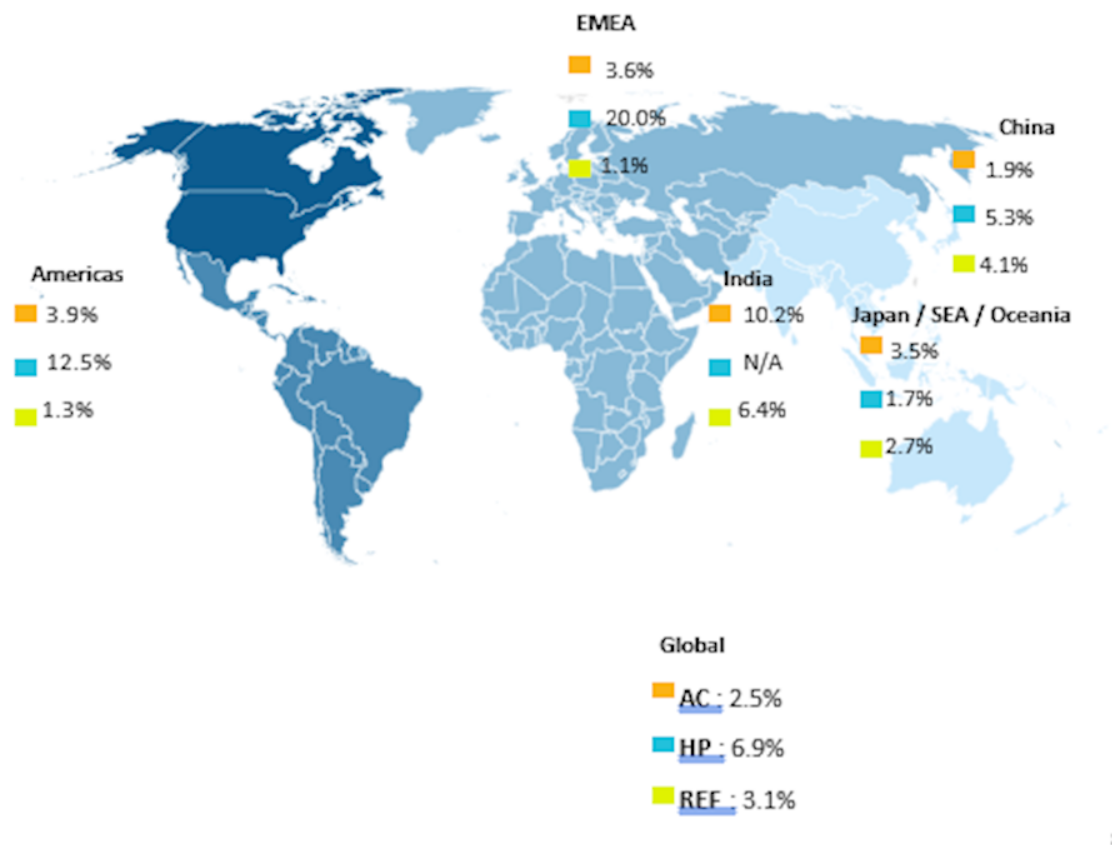World compressors study 2022

|
| CAGR of compressor sales by volume 2021 to 2026. |
In October 2022, BSRIA announced that it had completed an update of the World Compressor study, which analyses sales of compressors worldwide for applications in Air Conditioning (AC), Heat Pumps (HP), and Refrigeration (REF). The study is composed of five separate regional reports: Americas, EMEA, India, China, and Rest of Asia. In the latter the data is segmented between Japan and the other Asian countries – South-East Asia, Oceania.
This ambitious project uses as a basis the extensive knowledge and experience built over the years through research BSRIA carried out in all three application segments, worldwide. It provides insightful details on market sizes, trends and drivers to answer the information needs of all stakeholders.
The new study is aimed at updating the analysis for sales of compressors for the current year (2022), as well as extending the outlook for sales up to 2026. Forecasts are correlated with the extensive portfolio of studies published by BSRIA this year in the fields of AC, HP, and REF, as well as the latest macroeconomic analysis.
Sales experienced a significant decline in 2020, caused by the outbreak of Covid-19, but the global compressor market recovered forcefully in 2021 and was estimated at 502.1 million units in 2022 (3% growth), while value was shored up due to inflation, at USD 48.6 billion (15% growth). This includes compressors for air conditioning (207.3 million units), heat pumps (5.4 million), and refrigeration (289.4 million). This strong rebound has already placed the market above its pre-pandemic level. It was propelled in particular by rotary compressors in air conditioning applications.
Reciprocating compressors dominate the market in volume with an estimated 288.0 million units sold in 2022, as the use of small hermetic for household and light commercial appliances accounts for the bulk of sales. In second place come rotary compressors (197.0 million), which are sold mostly for AC applications and heat pumps and have been bolstered by the surge in sales of residential HVAC systems. Scroll are in the third position with 17 million units, this compressor type is being challenged by rotary in the lower capacities, but on the other hand they are gaining traction in larger capacity segments, as their performances increase.
Screw and centrifugal compressors, both standard and oil free, account for a much smaller share in number of units, yet they command together a sizeable market value of USD 3.3 billon thanks to their high selling prices. By 2026, the compressor market is expected to reach the total value of USD 52.5 billion, its highest performance ever, as applications in air conditioning, heat pumps and refrigeration will continue to expand.
In addition, drivers such as energy efficiency, the uptake of refrigerants with a lower environmental footprint, and the improvements in compressor capacities and performances are expected to push the value of the compressor market higher by leveraging sales growth.
All the market analysis carried out for the World Compressor study was supported by the extensive portfolio of market reports published over the years by BSRIA in the HVAC & Refrigeration sectors, worldwide.
For more information contact BSRIA at www.bsria.com/uk.
This article was originally published on the BSRIA website in October 2022. https://www.bsria.com/uk/news/article/world_compressors_study_2022_update/
--BSRIA
[edit] Related articles on Designing Buildings
- Air compressor.
- BSRIA articles on Designing Buildings Wiki.
- BSRIA Compressor Study September 2020 - The Americas and China.
- Compression refrigeration.
- Ground source heat pumps.
- HFC phase out.
- R22 phase out.
- R404A phase out.
- Refrigerant selection.
- Refrigerant.
- World air conditioning, heat pump and refrigeration compressors market March 2022.
Featured articles and news
One of the most impressive Victorian architects. Book review.
Common Assessment Standard now with building safety
New CAS update now includes mandatory building safety questions.
RTPI leader to become new CIOB Chief Executive Officer
Dr Victoria Hills MRTPI, FICE to take over after Caroline Gumble’s departure.
Social and affordable housing, a long term plan for delivery
The “Delivering a Decade of Renewal for Social and Affordable Housing” strategy sets out future path.
A change to adoptive architecture
Effects of global weather warming on architectural detailing, material choice and human interaction.
The proposed publicly owned and backed subsidiary of Homes England, to facilitate new homes.
How big is the problem and what can we do to mitigate the effects?
Overheating guidance and tools for building designers
A number of cool guides to help with the heat.
The UK's Modern Industrial Strategy: A 10 year plan
Previous consultation criticism, current key elements and general support with some persisting reservations.
Building Safety Regulator reforms
New roles, new staff and a new fast track service pave the way for a single construction regulator.
Architectural Technologist CPDs and Communications
CIAT CPD… and how you can do it!
Cooling centres and cool spaces
Managing extreme heat in cities by directing the public to places for heat stress relief and water sources.
Winter gardens: A brief history and warm variations
Extending the season with glass in different forms and terms.
Restoring Great Yarmouth's Winter Gardens
Transforming one of the least sustainable constructions imaginable.
Construction Skills Mission Board launch sector drive
Newly formed government and industry collaboration set strategy for recruiting an additional 100,000 construction workers a year.
New Architects Code comes into effect in September 2025
ARB Architects Code of Conduct and Practice available with ongoing consultation regarding guidance.
Welsh Skills Body (Medr) launches ambitious plan
The new skills body brings together funding and regulation of tertiary education and research for the devolved nation.
Paul Gandy FCIOB announced as next CIOB President
Former Tilbury Douglas CEO takes helm.
























